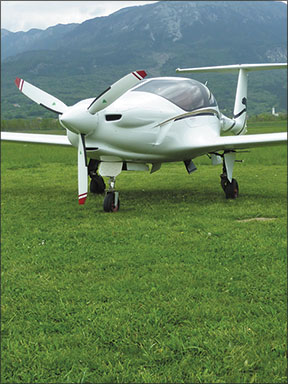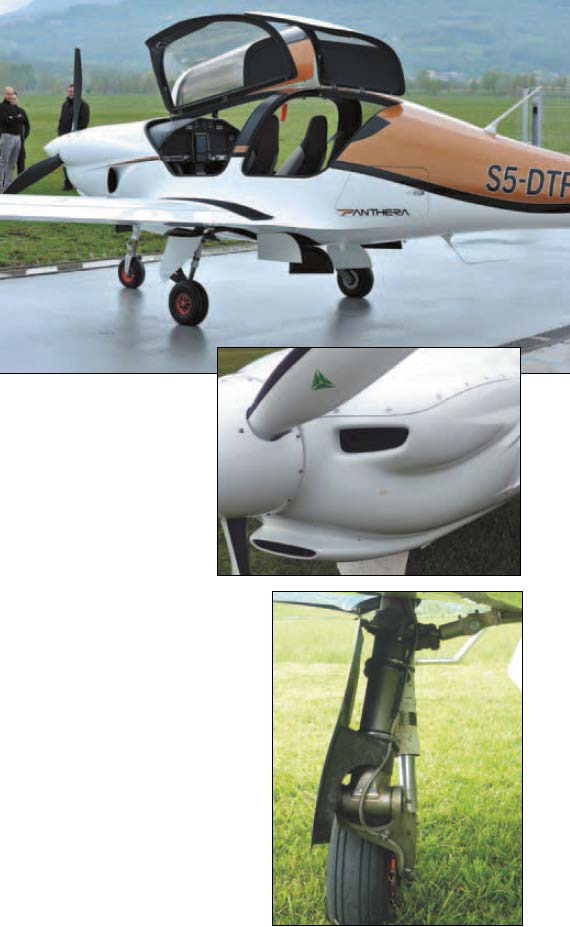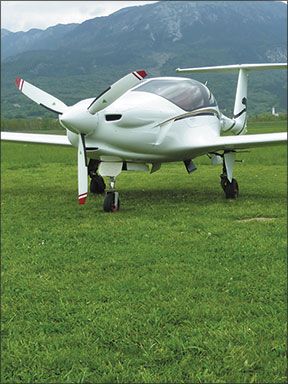How about this for an overused cliché? “It looks fast standing still.” It’s been applied to everything from cars, to boats and the occasional airplane, with arguable truth. But when Pipistrel’s exotic Panthera appeared as a prototype two years ago, it was mobbed at the Aero Expo in Friedrichshafen and none of the people waiting in line to see it were heard debating its sleek good looks.

Now, the airplane is 100-plus hours into its flight tests and still some distance from certification. On a recent trip to Europe, we visited the Pipistrel factory in Slovenia and got a close look at the Panthera, along with a flight demo to check out the airplane’s flight characteristics. If another cliché is true, airplanes fly like they look, the Panthera confirms that. But it also confirms that not all airplanes are as fast as they look or were predicted to be. More on that later.
The executive summary: The Panthera is a superbly crafted retractable with a comfortable interior, good range and payload and, in our view, the best-looking airplane to emerge since Cessna clipped the struts off the Cardinal. But it needs better runway performance and another 15 knots of cruise speed, at least, would make it a strong contender, albeit not a cheaper one.
Pipistrel
Pipistrel is, to a degree, a product of the fall of the Iron Curtain. But it’s not a relic of the aviation manufacturing skill base the former Soviet Union established in Eastern Europe during the Cold War. Slovenia is the northernmost segment of the former Yugoslavia and the company’s Ajdovscina factory is located just across the Italian border east of Trieste. Company founder Ivo Boscarol fed his lifelong aviation interest by building and flying hang gliders beneath the regulatory and security radar.
Following the dissolution of Yugoslavia and Slovenia’s eventual entry into the European Union, he began building powered gliders and now a line of European ultralights that sell as LSAs in the U.S. The Virus and Sinus are Pipistrel products and between those and the gliders, Pipistrel builds about 120 airframes a year.
Boscarol’s ethos has been less pure speed than efficiency, a philosophy the company used to win the $1.35 million NASA Green Flight Challenge in 2011 with the Taurus G4. The challenge required the winning aircraft to fly 200 miles in under two hours on less than one gallon of fuel per occupant, or the equivalent electrical energy. The twin-fuselage G4, an all-electric design, crushed the challenge, using but half of the allowed energy allotment.
The G4 was both faster—by 6 MPH—and more economical than the second place finisher, with the equivalent of 403.5 MPG. The competition had both promotional and practical applications, demonstrating Pipistrel’s prowess in low-energy flight and employing the same type of brushless DC motor Pipistrel will use in the electric version of the Panthera.

High Ambition
You read that right. In addition to the gasoline powerplant, Pipistrel plans a pure electric version and also a hybrid-drive variant. Pipistrel’s Tine Tomazic showed us the plans for the latter and although it appears to be quite far along, we can’t judge how realistic it is for the short term. For the time being, Pipistrel has its hands full re-engineing the gasoline model.
When it first appeared two years ago, Pipistrel predicted the Panthera would fly at around 200 knots on 10 gallons per hour, burning readily available mogas, at least in Europe.
The planned engine was Lycoming’s 210-HP IO-390. However, as the project unfolded, Lycoming revealed that it couldn’t make the IO-390 deliver full rated power on mogas with sufficient detonation margin. So in early 2014, Pipistrel announced that it was switching to the 260-HP Lycoming IO-540-V4A5, which is approved for 93 AKI fuel, if not necessarily exactly automotive gasoline.
This appears to be a point of contention because Lycoming’s SI 1070 approving 93 AKI fuel for the model of IO-540 Pipistrel plans to use specifies a Reid vapor pressure requirement of 9 PSI or less, which is in the range of avgas. In Europe, fuels with 98 research octane (93 AKI) are available, including at some airports. While these meet the octane requirement, they may or may not meet the vapor pressure requirement, according to Lycoming. Sources in the fuel industry we’ve spoken with are mixed on this issue. “To us, the important thing is not which fuel or mogas, but that the airplane’s future isn’t tied to 100LL,” Tomazic said.
“The decision on the engine was twofold; ”says Pipistrel’s Tomazic. “Forty percent is that the IO-390 turned out to be not feasible to run on mogas. The 60 percent comes from checking the current backlog and seeing where these airplanes will fly. A big majority of the people who order the airplanes fly hot and high every day,” Tomazic added. That includes South Africa, Argentina, Mexico and Colorado, to name a few locales from which 65 Panthera orders have come. Tomazic said Lycoming made a credible effort at making the IO-390 run on fuels other than avgas, but the physics just didn’t work.
With the IO-540, he says, owners will have at least 200 HP available at the prop shaft except in extreme con
ditions, something that can’t be said of the IO-390. And what of the weight? Tomazic concedes it’ll be a 90-pound hit over the smaller engine.
“Because the low-speed flight side of the envelope turned out so well, we can bump the maximum takeoff weight by 200 pounds. So in the end, we have an airplane that can deliver what we can call the original design horsepower between 190 and 200,” Tomazic says. Physically, the larger engine will fit under the same cowling because Pipistrel had envisioned both the possibility of a larger engine and the planned hybrid drive. (See sidebar above.)
Light, Slick, Strong
Viewed from any angle, the Panthera looks like an airplane built by a glider company—light and slick, although given the initial performance shortfall, it’s evidently not as slick as it looks. Basic fuselage construction is composite throughout, with two skins laminated over honeycomb or foam. The material is largely carbon fiber for stiffness, although the cockpit structure incorporates Kevlar plies to reduce sharding in the event of crash impact. The cockpit area is a safety cage consisting of stiff beams connecting the firewall to the cabin ceiling.
The control surfaces are composite layups, with no foam or honeycomb. This was done, Tomazic says, to make them easier to field repair and to mass balance during construction. All of the control circuitry is push-pull tubes, except for the rudder, which is via cables. The landing gear system is Mooney style; all-electric with a motor/transmission raising the gear through rods to each leg. Emergency extension is done via a crank between the front seats. The retracted struts and trailing link gear are fully enclosed behind tightly fitted doors.
Flaps are similarly electric with about two-thirds span. Although they’re plain flaps, they do produce a slot as they extend, so it’s more accurate to call them a hybrid design. But the wing is clean of any rails or guides, for drag reduction.
Anticipating mogas in which vapor pressure might be an issue, the fuel system consists of a pair of wing tanks plumbed through smaller header tanks with return lines and flapper valves for vapor suppression. Capacity is 28 gallons per side (105 liters) for a total of 56 gallons (210 liters). For a four-cylinder engine, that capacity is about right and would give a little over 800 miles of still-air range at 170 knots, but closer to 1000 miles if Pipistrel gets the airframe to 200 knots. But 56 gallons strikes us as stingy for a six-cylinder engine, even if Pipistrel insists the fuel burn won’t increase more than about half a gallon an hour. An extended-range option will offer another 16 gallons or 30 liters per side for a typical endurance, with reserve, of about six hours. That’s an easy 1000 miles, even at the slower cruise speed.
It’s too soon to say where the Panthera will come out on weight, but it could be impressively light. The aircraft we flew weighed 1590 pounds empty (723 kg) and without the gross weight increase Pipistrel envisions, that’s a useful load of 1050 pounds (556 kg) on a stated gross weight of 2640 pounds or 1200 kg. Full fuel payload with standard tanks is 714 pounds (324 kg). If those numbers stand, the Panthera is a full-seats, full- tanks airplane. If the gross is bumped up 200 pounds, it will gain enough load capacity for more fuel and baggage. The empty weight includes a ballistic recovery parachute system.
Flight Trial
Ingress into the Panthera is through a pair of gullwing-style hatches for the front and a single hatch on the left side of the airplane for the backseats. You’ll graze your head on the open hatch the first time, but not the second. The cabin is unexpectedly wide—49 inches (124 cm) at the shoulders—with plenty of headroom above a headset. Despite the raking windshield and a wide center beam that’s part of the cabin protective structure, the view forward is good and utterly expansive out the sides.
The panel in the airplane we flew had a Dynon Skyview, but Tomazic says Pipistrel isn’t sure what production versions will have. It seems likely to be a choice of the Skyview or Garmin G3X. But it won’t be a G1000 airplane. It will carry whatever autopilots support those systems.
Elsewhere on the panel, the center stack contains a Garmin GTN 650/750, electrical rockers below the main display on the pilot’s side and backup instruments along the top eyebrow. A nice digital climate control display is on the pedestal under the radios. Less nice, in our view, were switch/annunciators above the displays. It’s a minor point, but we thought these looked a little dated and didn’t match the exotic good looks of the rest of the airplane. Although they’re functional, they would benefit from some spiffing up.
Takeoff in the airplane is not unlike other slick retracts; the Mooney Ovation comes to mind. The Panthera accelerates quite briskly at first, then settles into a slower pace. Rotation comes at about 65 knots and the airplane waddles rather than bolts off the runway. But like the Mooney, once the gear is up, it gathers itself up, speeds up and heads for a climb rate north of 1000 FPM. Way north; at one point, we saw 1600 FPM in relatively smooth air.
The Panthera has center sticks, perfectly positioned for one-handed, fingertip control. Control forces are, well, smile inducing. The airplane is a delight in steep turns and once the sight picture is locked in, easy to keep on altitude. Tomazic said the Panthera’s slow-speed behavior is good and he’s right. But it needs a higher Vlo which, at 108 knots, takes some effort to achieve. Pipistrel hasn’t taken the envelope in that direction yet and our guess is unless there’s something quirky about the gear doors, the cert version may have higher speeds, including Vfe, which is also 108 knots.
The airplane looks like it should have the slow-speed habits of something similarly slick, say a Glasair III. Not really. The Panthera happily wallows around in the burble with plenty of warning that the stall is pending. When it comes, the Panthera feels like a more docile airplane, bobbing the nose and almost recovering on its own. We didn’t poke the cat’s cage with abusive inputs, but what we saw looked promising. But a little less so on the cruise speed. Pilot Robert Likar trimmed the airplane for level flight at 6000 feet, leaned to 39 liters (10.5 GPH) and we recorded about 174 knots TAS. What happened to the promised 200 knots? Tomazic says several things are at work. First, original modeling anticipated antennas buried in the fuselage, but initial certification reviews precluded that. Second, the company has been through five props and isn’t certain it’s got the right one yet. Tomazic says the IO-540, because of its additional takeoff thrust, will allow prop selection to bias toward cruise speed without having to compromise toward takeoff performance. He insists the airplane will be capable of 200 knots with the prop and drag cleanup. In our estimation, that’s a lot of speed to find. We’re hopeful, but not convinced yet, either.
Conclusion
Even without the promised cruise speed, the Panthera already hits a solid mark. Like Mooney, Pipistrel’s grail is efficiency and at 174 knots on 10.5 GPH, the Panthera raises the bar, if only incrementally. That’s 16.6 NMPG and we can’t find another four-place airframe that beats that. If Pipistrel can eke out another 10 knots on a half gallon with more robust takeoff performance, it’ll have a contender, in our view, perhaps just on looks alone. Its best-case useful load is shy of the Cirrus SR22 line, but its fuel economy is far better.
The Panthera has become somewhat of a poster child for less expensive aircraft certified under the CS23 revision. That’s what will allow the company to use uncertified avionics like the Skyview or G3X. Simpler certification requirements are supposed to reduce costs throughout the cert process.
When it debuted, the Panthera’s price was expected to be about $500,000. But Pipistrel’s latest price for the certified gasoline version is $614,000 (€445,000). That’s less than an equipped Cirrus, but only by a couple of percent.
We’re not surprised. CS23 or not, no one has yet delivered on the less expensive, fully capable new airplane. The reality is likely to be that airplanes of this class will cost $600,000 or more; $500,000 would a winner, but at this juncture, it doesn’t look realistic.





